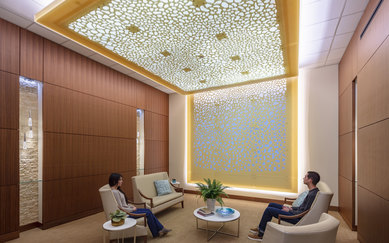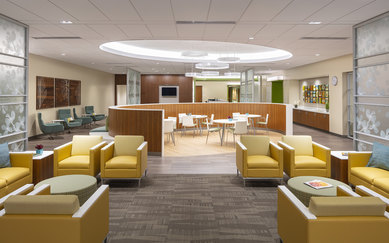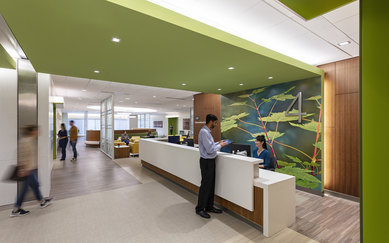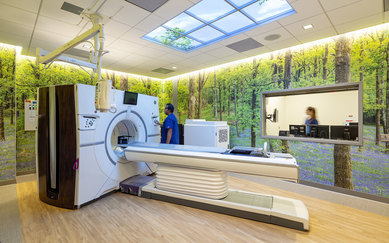Adapting Interior Design Strategies for Integrated Project Delivery
One million square feet. That’s the size of Sutter Health’s new California Pacific Medical Center (CPMC) Van Ness Campus Hospital. If you unstacked its twelve stories and laid them side by side, it would more than cover Alcatraz Island. This new flagship facility is a beautiful and inviting new home for what had been separate medical campuses, uniting on one site an adult acute care hospital, a women’s center, and a children’s hospital, while maintaining the identity of each. It is, by any measure, a tall order.
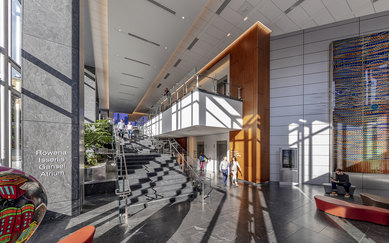
To take on a project this massive—and massively complex—Sutter Health chose the Lean integrated project delivery (IPD) method, in which the architect, client, contractor, and subcontractors all work together in the same location, towards the same goals, at the same time. Lean IPD provides a structure for collaboration and coordination between the owner, designers, and builders far beyond what can occur in the typical design-bid-build construction process.
The goal of this new process, of course, is to improve the qualitative, aesthetic, functional, and financial outcomes of the project by realigning the expectations and incentives of conventional contracting methods. Lean IPD also changes the way designers work by bringing more information and input into the early design process. For the interiors team at SmithGroup, it meant that we had to radically rethink the way that we develop and communicate our planning and design concepts.
The IPD Advantage
In the traditional design-bid-build process, architects begin with the planning and schematic design phases, identifying the client’s goals and producing rough drawings that indicate the basic design concepts. In each subsequent phase, we further develop the design, refine the drawings and documents, and then produce detailed construction documents that the client can send to contractors for bidding.
In contrast, the Lean IPD process integrates the client, the architects, the contractors, and the subconsultants right from the start to collaborate on developing a design that is constructable and affordable while maintaining high quality. The budget can be controlled because evolving designs are continually being reviewed for cost and constructability, with the entire IPD team suggesting opportunities for improvements and efficiencies. Everyone works together to develop a complete and detailed project estimate as the design progresses, which results in less rework and fewer change orders than the traditional design-bid-build process.
For the Van Ness Campus hospital, SmithGroup needed to clearly articulate the interior design concepts for the rest of the team very early in the project. We also wanted to ensure that the integrity of the design would be maintained as the process of estimating, design, and construction proceeded, and we knew typical construction documents weren’t going to be enough to serve this process. We worked with Sutter Health in the earliest phases to articulate a clear overall concept for the design, explaining what aspects were important and why. This helped to align the IPD team around the project’s design goals, ensuring that the entire team was committed to realizing the design ideas when cost and constructability issues arose.
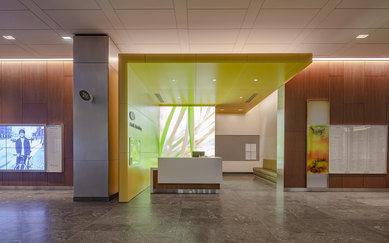
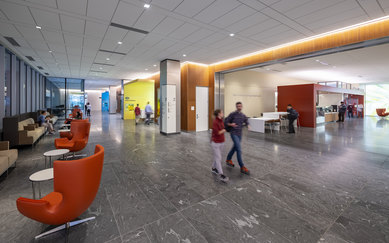
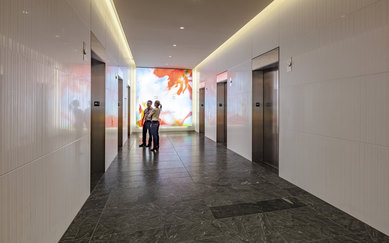
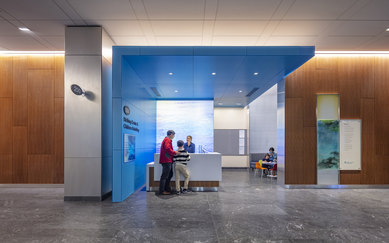
Maintaining Patient-Centered Design Within the IPD Process
Hospitals have long had a reputation for feeling anonymous, institutional, and intimidating—qualities that aren’t conducive to healing or wellness. Sutter, SmithGroup, and the IPD team set out to combat these negative associations outside and inside the Van Ness Campus for patients, families, and staff so that we could reinforce and support healing and health.
We developed design hierarchies to aid in clear wayfinding throughout the large hospital. We applied these hierarchies through architectural forms, graphic imagery, lighting, material placement, and consistent detailing throughout the building. Recognizing the importance of creating a sense of welcome in the hospital, we clearly defined entrances, meeting points, and wayfinding elements to simplify and communicate the organization of the hospital without an overreliance on signage. We introduced familiar domestic forms and materials like wood, art, and upholstered seating in patient and family areas and provided pleasant exterior views enhanced by five rooftop gardens. We employed these strategies in all areas of the hospital, but we emphasized the design of patient areas.
To maintain the design integrity of these concepts as the project evolved, SmithGroup created typology diagrams for different aspects of the design. The entire IPD team referred to these typology diagrams to understand what areas were a design priority and which materials were essential. These diagrams clarified the importance of the selected materials and showed how the materials were distributed throughout the building. They also helped us make design choices for each floor that were consistent with the color palette and concept for that floor, while also making sense within the overall hospital design. This became increasingly important near the end of the project when some patterns and materials went out of production and alternatives needed to be selected.
The typology diagrams helped us design and deploy four different types of interior walls, each of which plays a role in the overall organization and wayfinding scheme for the hospital. Each type of wall has a purpose: some indicate major thoroughfares that help orient visitors as they navigate the building, which covers an entire city block; others create unique identities that help to differentiate and organize the hospital’s many departments. 'Luminous' walls are internally or externally lit to serve as beacons; 'wayfinding' walls are marked by distinctive materials that help visitors identify and navigate public areas—for example, wood walls line major thoroughfares; 'functional' walls for non-public areas use a simpler but related material palette; and 'accent' walls, marked by strong color, provide cues to the organization and function of departmental space. The contractors used our typology diagrams to identify areas in plan where SmithGroup had specified each kind of wall, making it easy for them to assign a cost. The contractor could easily see just how small a percentage of the walls relied on high-cost materials—a wood wall is more expensive than drywall, for example—and it was clear that we had applied these materials strategically.
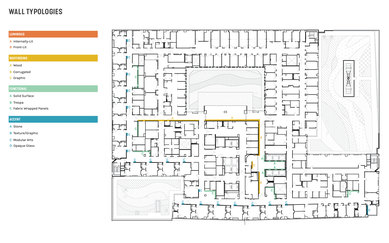
The typology diagrams created project clarity. Because these typologies had been reviewed and agreed upon with our client and the IPD team, and everyone understood their importance for the project’s success, we avoided the value engineering process that all too often ends up eliminating distinctive finishes in the name of cost-cutting. When tradeoffs were required, we made them in consultation together.
A large part of the Van Ness Campus hospital’s success came from working in a 'Big Room' environment with our client and trade partners. There’s an energy and creativity that happens across the team when we’re in such close proximity day-to-day. Working closely together encouraged quick resolutions to challenges—we could immediately huddle with our appropriate trade partners and make a sound decision, moving the project ahead.
Working with our trade partners so closely gave us a much better understanding of their needs than we would get with the traditional design-bid-build process. We learned how the trades work with materials and their typical construction methods, and our trade partners developed a better understanding of how to consider their work from a design perspective. They were able to bring their specialized knowledge to improve the quality of the final product. The relationship between designer and trades can sometimes turn adversarial in more traditional delivery methods, but with IPD, our trade contractors became advocates for the overall design narrative.
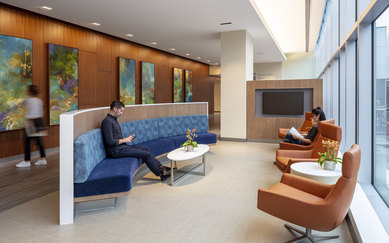
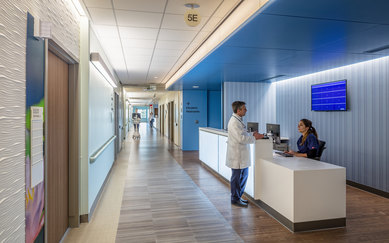
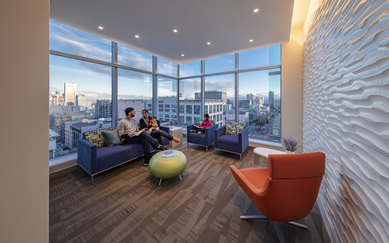
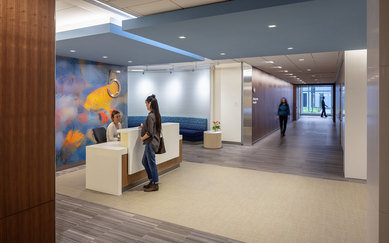
Achieving Greater Understanding Between Architects and Contractors
Through this project, we came to realize the contrast between how architects think about buildings during design and how contractors think about buildings during construction. Architects tend to design holistically—we don’t design each floor in sequence but as part of an interrelated whole. Contractors primarily think sequentially: they develop an attack plan for building, breaking down the construction of each floor into a series of discrete steps and dividing the whole into specific zones so that each trade partner—plumbers, framers, electricians, etc.—can have sole access to that area for a defined period of time, in order to carry out their tasks unimpeded.
This difference in thinking sometimes proved a challenge. In using IPD, we were shortening the project schedule a great deal, encouraging the general contractor and trades to jump forward on their construction planning while the design was still being finalized. As the team resolved final design issues across the project, some friction developed between the architects and the trades who had pushed ahead in their respective areas. Our team culture and shared goals helped us to successfully overcome these issues, but future projects should consider creating a shared schedule of design release points that integrates designer, client and manufacturer input with the needs of the trades in order to clarify this process.
The IPD process thrives on interdependence and communication, with each teammate at every level openly sharing their expertise. The architect, however, is the team member who is trained to envision the project as a completed whole and shape the project as an interconnected network of ideas and materials, rather than as a series of desires and operational criteria or as a linear problem of construction. The architect proves their value by creating and revising design ideas, thinking freely and holistically within the constraints of the project to solve problems as they arise. This helps projects hold together stylistically, convey meaning and intent, and speak to themes beyond the project itself.
Architects in an IPD project need to incorporate the concerns of the contracting team more fully into their thinking, understanding and respecting their issues, knowledge, and pressures. There are so many synergies possible when we collaboratively engage and combine all of our expertise—as builders, suppliers, owners, and designers—working toward a common goal. By using tools like the typologies developed for the Van Ness project to clarify everyone’s understand of each design element, we were able to ensure the built design carried our concept throughout the very large, complex facility. The result is a sophisticated and welcoming environment where patients, visitors and staff are thriving.
